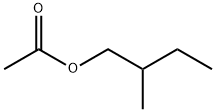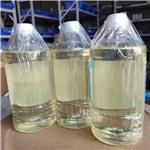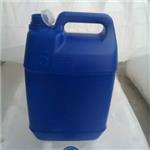Description
2-Methylbutyl acetate has an apple peel and banana odor.
Chemical Properties
All isomers of amyl acetate are highly flammable,
colorless to yellow, watery liquids.
Chemical Properties
2-Methylbutyl acetate has an apple peel and banana odor.
Occurrence
Reported found in apple, apple juice, pear, Scotch whiskey, white wine, Bantu beer, beer, cider, cocoa, fig,
grape, melon, pineapple, plum, baked potato, rum, sherry, strawberry, wine, apricot, vinegar, sweet cherry, pimento berry, olive, rye
bread, cognac, malt whiskey, rum, nectarines, mountain papaya and mango.
Definition
ChEBI: The acetate ester of 2-methylbutan-1-ol.
Aroma threshold values
Detection: 5 to 11 ppb
Taste threshold values
Taste characteristics at 20 ppm: fruity, sweet, banana, juicy fruit and tutti-frutti note.
Potential Exposure
(n-isomer): Primary irritant (w/o allergic
reaction), (sec-isomer) Human Data. Amyl acetates are
used as industrial solvents and in the manufacturing and
dry-cleaning industry; making artificial fruit-flavoring
agents; cements, coated papers, lacquers; in medications
as an inflammatory agent; pet repellents, insecticides and
miticide. Many other uses.
Shipping
UN1993 Flammable liquids, n.o.s., Hazard
Class: 3; Labels: 3-Flammable liquid, Technical Name
Required.
Incompatibilities
Vapors may form explosive mixture with
air. Incompatible with oxidizers (chlorates, nitrates, peroxides,
permanganates, perchlorates, chlorine, bromine, fluorine,
etc.); contact may cause fires or explosions. Keep
away from alkaline materials, strong bases, strong acids,
oxoacids, epoxides, nitrates. May soften certain plastics.
Toxics Screening Level
The current Initial Threshold Screening Level (ITSL) for 2-methyl butyl acetate is 1100 μg/m3.
Waste Disposal
Dissolve or mix the material
with a combustible solvent and burn in a chemical incinerator
equipped with an afterburner and scrubber. All federal,
state, and local environmental regulations must be observed.
In accordance with 40CFR165, follow recommendations for
the disposal of pesticides and pesticide containers. Must be
disposed properly by following package label directions or
by contacting your local or federal environmental control
agency, or by contacting your regional EPA office.




